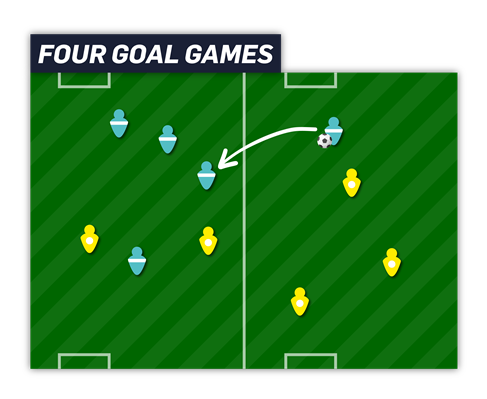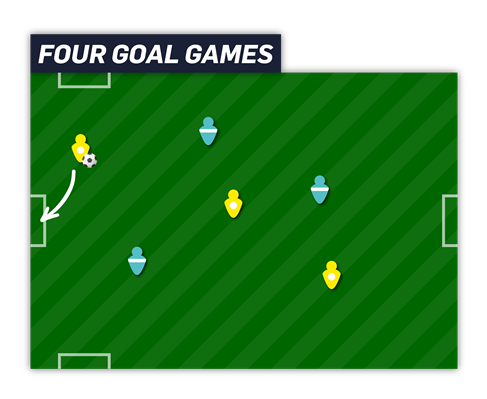In this blog, The FA’s coach development officer, Suey Smith explains how 4 goal games can be used and the benefits they bring.
Some coaches may or may not have used multiple goals in training sessions before. Either way, this short article will give you some insights into the benefits your players may gain from playing 4-goal games.
Including multiple goals can provide plenty of opportunities for players to learn and improve their decision-making skills. Whilst having 4 goals on a pitch takes away some of the realism of a normal game, it's our role as the coach to manage any impact of this and be clear on the focus and aims for the session.
Players love matches, no matter what age, they also love scoring, so the motivation to have the opportunity to score more goals in training can be a quick win for you.
Let's have a look at how these games may be used.
5v5 – 2 goal game
This is where 4 goals are placed around a pitch that is divided in two by a line (like the halfway line). There should be two goals in each half, evenly spread out.

- Players attack the two goals which are allocated to their team.
- A challenge for players could be whether to check if they can see both halves of the pitch.
- If a team scores from the ball being crossed over the white line 2 it's worth 2 goals.
This challenge supports players' decision-making and allows you to observe and offer coaching points to achieve the task if needed.
3v3 – 4 Goal Game
This is where 4 goals are placed around a pitch. Teams of 3 play against each other and some specific rules for this practice could be:
- Yellows start with the ball and can attack in any goal to start with.
- Once the first goal has been scored, they are not allowed to use that goal again until the next goal has been scored.
- If the blues win possession of the ball from the yellows, they can score in any of the 4 goals to start with.
- A first-time finish could be worth 2 goals.

Opening the body to receive the ball properly is a skill that helps players to see both sides of the pitch and switch the play if needed. We find this skill is especially important for players who operate in the middle of the pitch and/or who may be overloaded in one-half of the pitch. 4-goal games can offer a perfect opportunity for players to practice this skill.
The use of questions to your players in these practices is also important. Below are some useful examples:
| What did you see to think about switching the play? (players in space/an overload) | What might help you to see both goals? (body shape is side-on) | Is there an overload on the opposite side of the pitch? If so, what may you think of doing quickly? (switching play) |
| Before receiving the ball what, might you do? (look over the shoulder) | Why is it important to try and have an open body? (to receive the ball properly) | Do you always have to switch the ball just because it's worth 2 goals? (questions the importance of 2 goals v losing that opportunity) |
Supporting the 4-corner model
These games can also help to support all corners of The FA 4-corner model, here are some examples:
| Technical | Psychological |
|---|---|
|
|
| Physical | Social |
|
|
Like most practices, there are often trade-offs using 4 goal games, these include:
- Defending can become unrealistic at times, requiring defenders to try to move attackers into positions that aren’t a replica of a normal game situation e.g. showing them inside or outside.
- Positioning such as being goal side can become confusing if playing with multiple goals.
- Losing some opportunity to play through the centre of the pitch to a striker.
Hopefully, this blog has helped to demonstrate some ways 4-goal games can be used and the benefits of using them. We’d love to hear if you have been using them and if you have come up with any other adaptations.
What do you think of Suey’s blog? Have you come up with other adaptations? If so, let us know in the comments below!


